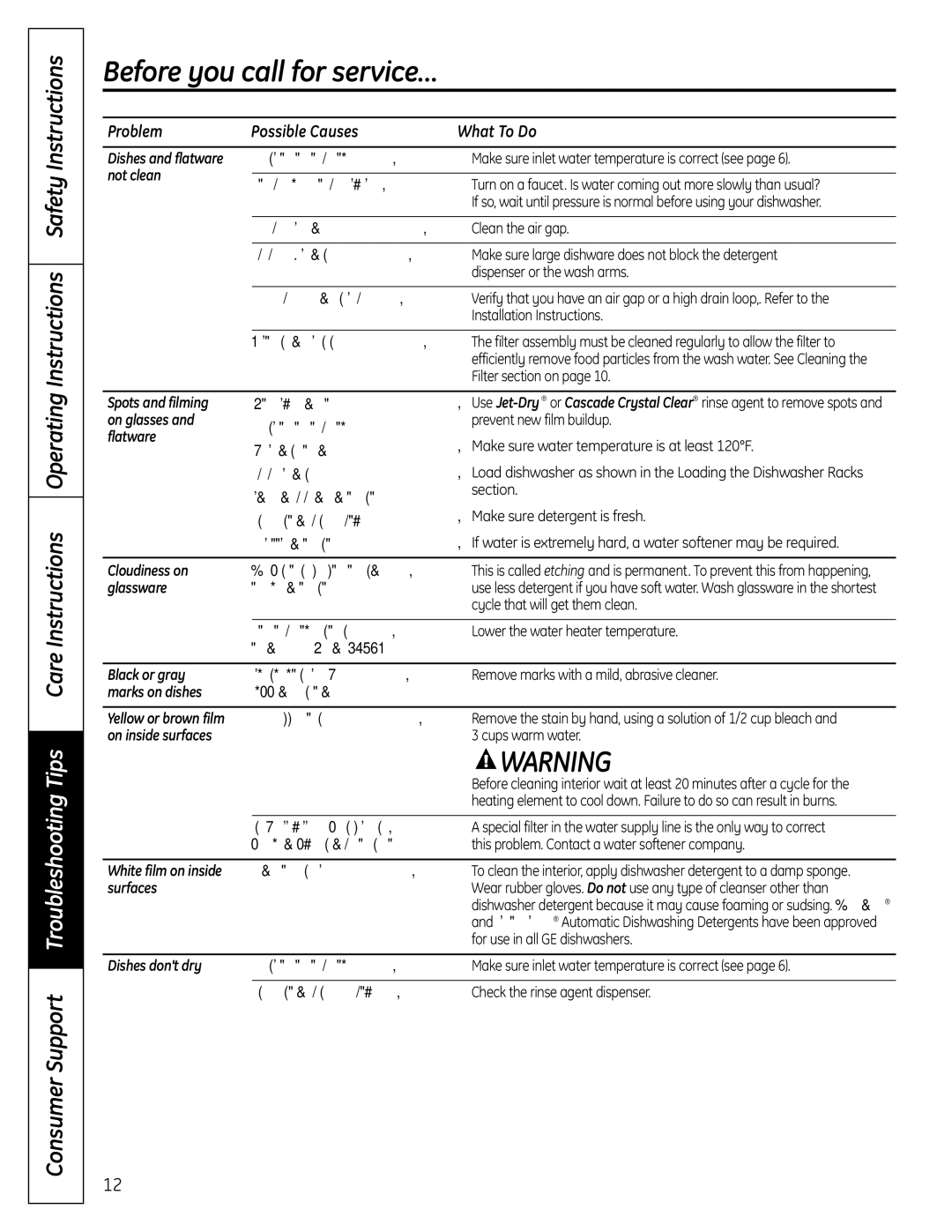
Instructions
Before you call for service…
Problem | Possible Causes | What To Do |
Safety
Dishes and flatware not clean
Low inlet water temperature | • Make sure inlet water temperature is correct (see page 6). |
Water pressure is temporarily low | • Turn on a faucet. Is water coming out more slowly than usual? |
| If so, wait until pressure is normal before using your dishwasher. |
|
|
Air gap is clogged | • Clean the air gap. |
|
|
Improper rack loading | • Make sure large dishware does not block the detergent |
| dispenser or the wash arms. |
Consumer Support Troubleshooting Tips Care Instructions Operating Instructions
| No air gap or high drain loop | • | Verify that you have an air gap or a high drain loop,. Refer to the | |
|
|
| Installation Instructions. | |
|
|
|
| |
| Filter needs cleaning | • | The filter assembly must be cleaned regularly to allow the filter to | |
|
|
| efficiently remove food particles from the wash water. See Cleaning the | |
|
|
| Filter section on page 10. | |
|
|
|
| |
Spots and filming | Extremely hard water | • | Use | |
on glasses and | Low inlet water temperature |
| prevent new film buildup. | |
flatware | • |
| ||
Overloading the dishwasher | Make sure water temperature is at least 120°F. | |||
| ||||
|
|
| ||
| Improper loading | • | Load dishwasher as shown in the Loading the Dishwasher Racks | |
| Old or damp powder detergent |
| section. | |
| • |
| ||
| Rinse agent dispenser empty | Make sure detergent is fresh. | ||
|
|
| ||
| Too little detergent | • | If water is extremely hard, a water softener may be required. | |
|
|
|
| |
Cloudiness on | Combination of soft water and | • | This is called etching and is permanent. To prevent this from happening, | |
glassware | too much detergent |
| use less detergent if you have soft water. Wash glassware in the shortest | |
|
|
| cycle that will get them clean. | |
|
|
|
| |
| Water temperature entering | • | Lower the water heater temperature. | |
| the dishwasher exceeds 150°F |
|
| |
|
|
|
| |
Black or gray | Aluminum utensils have | • | Remove marks with a mild, abrasive cleaner. | |
marks on dishes | rubbed against dishes |
|
| |
|
|
|
| |
Yellow or brown film | Tea or coffee stains | • | Remove the stain by hand, using a solution of 1/2 cup bleach and | |
on inside surfaces |
|
| 3 cups warm water. | |
|
|
| WARNING | |
|
|
| Before cleaning interior wait at least 20 minutes after a cycle for the | |
|
|
| heating element to cool down. Failure to do so can result in burns. | |
|
|
| ||
| An overall yellow or brown film can • | A special filter in the water supply line is the only way to correct | ||
| be caused by iron deposits in water this problem. Contact a water softener company. | |||
|
|
|
| |
White film on inside | Hard water minerals | • | To clean the interior, apply dishwasher detergent to a damp sponge. | |
surfaces |
|
| Wear rubber gloves. Do not use any type of cleanser other than | |
|
|
| dishwasher detergent because it may cause foaming or sudsing. Cascade® | |
|
|
| and Electrasol® Automatic Dishwashing Detergents have been approved | |
|
|
| for use in all GE dishwashers. | |
|
|
|
| |
Dishes don’t dry | Low inlet water temperature | • | Make sure inlet water temperature is correct (see page 6). | |
|
|
|
| |
| Rinse agent dispenser is empty | • | Check the rinse agent dispenser. | |
12
